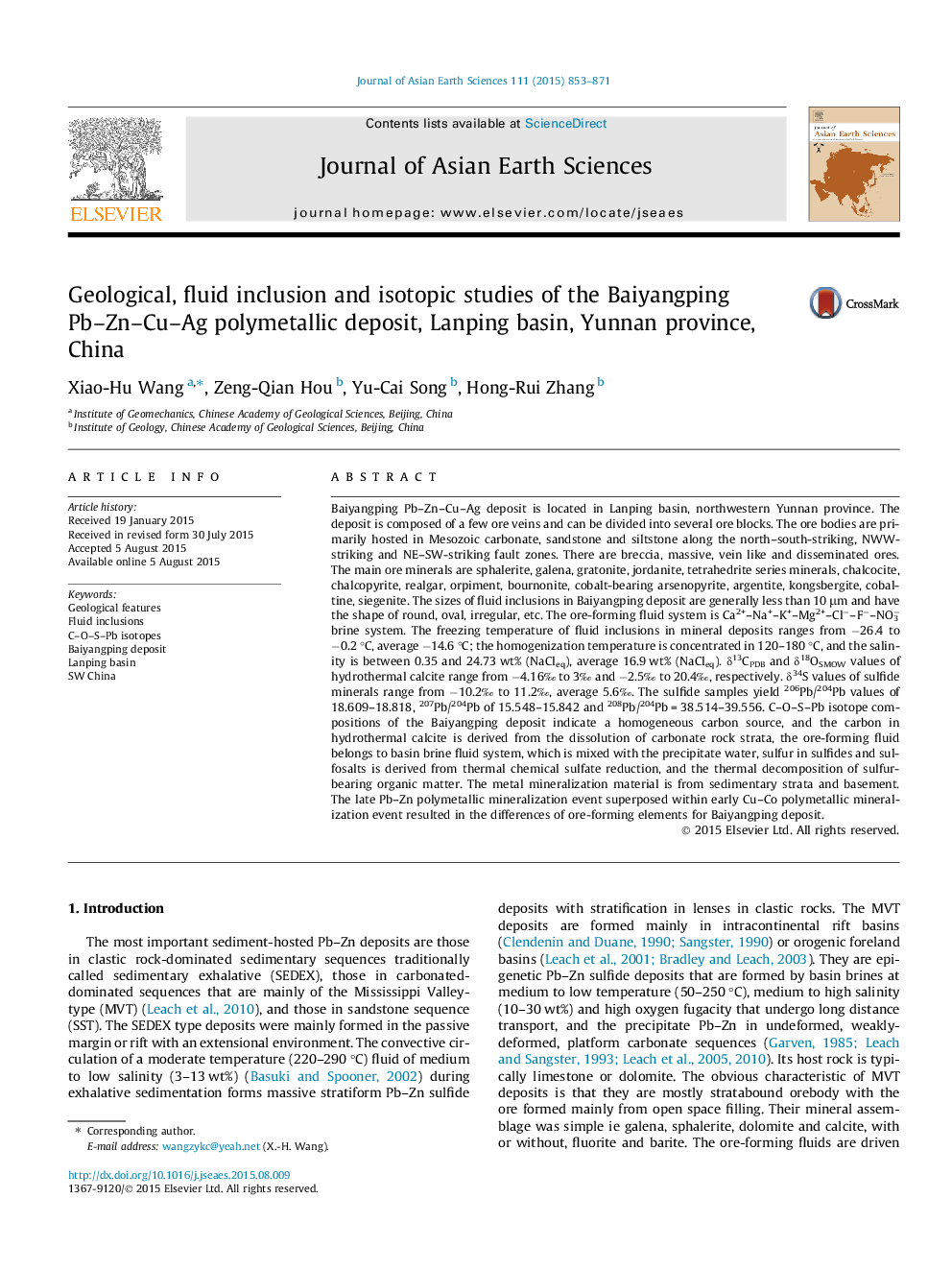| کد مقاله | کد نشریه | سال انتشار | مقاله انگلیسی | نسخه تمام متن |
|---|---|---|---|---|
| 6444250 | 1640358 | 2015 | 19 صفحه PDF | دانلود رایگان |
عنوان انگلیسی مقاله ISI
Geological, fluid inclusion and isotopic studies of the Baiyangping Pb-Zn-Cu-Ag polymetallic deposit, Lanping basin, Yunnan province, China
دانلود مقاله + سفارش ترجمه
دانلود مقاله ISI انگلیسی
رایگان برای ایرانیان
کلمات کلیدی
موضوعات مرتبط
مهندسی و علوم پایه
علوم زمین و سیارات
زمین شناسی
پیش نمایش صفحه اول مقاله

چکیده انگلیسی
Baiyangping Pb-Zn-Cu-Ag deposit is located in Lanping basin, northwestern Yunnan province. The deposit is composed of a few ore veins and can be divided into several ore blocks. The ore bodies are primarily hosted in Mesozoic carbonate, sandstone and siltstone along the north-south-striking, NWW-striking and NE-SW-striking fault zones. There are breccia, massive, vein like and disseminated ores. The main ore minerals are sphalerite, galena, gratonite, jordanite, tetrahedrite series minerals, chalcocite, chalcopyrite, realgar, orpiment, bournonite, cobalt-bearing arsenopyrite, argentite, kongsbergite, cobaltine, siegenite. The sizes of fluid inclusions in Baiyangping deposit are generally less than 10 μm and have the shape of round, oval, irregular, etc. The ore-forming fluid system is Ca2+-Na+-K+-Mg2+-Clâ-Fâ-NO3â brine system. The freezing temperature of fluid inclusions in mineral deposits ranges from â26.4 to â0.2 °C, average â14.6 °C; the homogenization temperature is concentrated in 120-180 °C, and the salinity is between 0.35 and 24.73 wt% (NaCleq), average 16.9 wt% (NaCleq). δ13CPDB and δ18OSMOW values of hydrothermal calcite range from â4.16â° to 3â° and â2.5â° to 20.4â°, respectively. δ34S values of sulfide minerals range from â10.2â° to 11.2â°, average 5.6â°. The sulfide samples yield 206Pb/204Pb values of 18.609-18.818, 207Pb/204Pb of 15.548-15.842 and 208Pb/204Pb = 38.514-39.556. C-O-S-Pb isotope compositions of the Baiyangping deposit indicate a homogeneous carbon source, and the carbon in hydrothermal calcite is derived from the dissolution of carbonate rock strata, the ore-forming fluid belongs to basin brine fluid system, which is mixed with the precipitate water, sulfur in sulfides and sulfosalts is derived from thermal chemical sulfate reduction, and the thermal decomposition of sulfur-bearing organic matter. The metal mineralization material is from sedimentary strata and basement. The late Pb-Zn polymetallic mineralization event superposed within early Cu-Co polymetallic mineralization event resulted in the differences of ore-forming elements for Baiyangping deposit.
ناشر
Database: Elsevier - ScienceDirect (ساینس دایرکت)
Journal: Journal of Asian Earth Sciences - Volume 111, 1 November 2015, Pages 853-871
Journal: Journal of Asian Earth Sciences - Volume 111, 1 November 2015, Pages 853-871
نویسندگان
Xiao-Hu Wang, Zeng-Qian Hou, Yu-Cai Song, Hong-Rui Zhang,